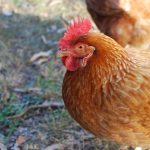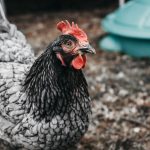The deep litter method is an efficient technique for managing chicken waste and providing warmth in winter. This approach involves allowing bedding materials like straw, wood shavings, or sawdust to accumulate in the chicken coop over time. As the bedding decomposes, it generates heat, helping to keep chickens warm during cold weather.
The deep litter method is a natural and sustainable way to maintain a healthy environment for chickens, reducing the need for frequent cleaning and providing insulation against low temperatures. This method also promotes chicken health by encouraging natural behaviors such as scratching and pecking. It creates a more natural environment, potentially reducing stress and improving overall well-being.
The decomposing bedding produces beneficial microorganisms that help control odors and reduce the risk of harmful pathogens in the coop. The deep litter method is a cost-effective and environmentally friendly approach to waste management and winter warmth for chickens.
Table of Contents
- 1 The benefits of the deep litter method for chickens
- 2 Factors to consider for keeping chickens warm in winter
- 3 Can the deep litter method alone keep chickens warm?
- 4 Supplementing the deep litter method for warmth
- 5 Other strategies for keeping chickens warm in winter
- 6 best practices for keeping chickens warm with the deep litter method
- 7 FAQs
- 7.1 What is the deep litter method for chickens?
- 7.2 How does the deep litter method keep chickens warm?
- 7.3 Is the deep litter method enough to keep chickens warm in all climates?
- 7.4 What are the benefits of using the deep litter method for chickens?
- 7.5 Are there any drawbacks to using the deep litter method for chickens?
Key Takeaways
- The deep litter method involves allowing bedding material to accumulate in the chicken coop, creating a composting environment that provides warmth and insulation for the chickens.
- Benefits of the deep litter method for chickens include improved air quality, reduced odor, natural pest control, and a source of compost for the garden.
- Factors to consider for keeping chickens warm in winter include adequate ventilation, draft prevention, proper insulation, and access to fresh water.
- The deep litter method alone may not be sufficient to keep chickens warm in extreme cold, so supplemental heating or insulation may be necessary.
- Supplementing the deep litter method for warmth can be done with additional bedding, heat lamps, heated waterers, and insulated coop designs.
- Other strategies for keeping chickens warm in winter include using solar-powered heaters, providing windbreaks, and ensuring the chickens have access to a warm, dry area.
- In conclusion, best practices for keeping chickens warm with the deep litter method involve a combination of proper coop management, supplemental heating, and attention to the chickens’ overall comfort and well-being.
The benefits of the deep litter method for chickens
Natural Insulation and Warmth
One of the primary advantages of this method is its ability to provide natural insulation and warmth for the chickens. As the bedding material decomposes, it generates heat, which helps to maintain a comfortable temperature in the coop. This natural heat source can be particularly beneficial for young or vulnerable chickens that may be more susceptible to cold temperatures.
Cost-Effective and Sustainable
Additionally, the deep litter method can help to reduce heating costs for chicken owners, as it provides a sustainable and cost-effective way to keep the coop warm.
Improved Air Quality and Reduced Maintenance
Another benefit of the deep litter method is its ability to improve air quality in the chicken coop. The decomposing bedding material creates beneficial microbes that help to control odors and reduce the risk of harmful pathogens. This can lead to a healthier environment for the chickens, as well as for the chicken owners who may spend time in or around the coop. Furthermore, the deep litter method can save time and effort for chicken owners, as it reduces the need for frequent cleaning and maintenance of the coop.
Overall, the deep litter method offers numerous benefits for chickens and their owners, making it a popular choice for managing waste and providing warmth in the winter.
Factors to consider for keeping chickens warm in winter

When it comes to keeping chickens warm in winter, there are several factors that chicken owners should consider. One important factor is the type of chicken breed, as some breeds are more cold-hardy than others. For example, breeds such as Orpingtons, Wyandottes, and Brahmas are known for their cold tolerance and can withstand lower temperatures without additional heating.
On the other hand, Mediterranean breeds like Leghorns and Minorcas are less cold-hardy and may require more attention to stay warm in winter. Another factor to consider is the size and ventilation of the chicken coop. A well-ventilated coop is essential for maintaining good air quality and preventing moisture buildup, which can lead to frostbite and respiratory issues in chickens.
However, too much ventilation can also allow cold drafts to enter the coop, so it’s important to strike a balance between airflow and insulation. Additionally, providing adequate bedding material in the coop is crucial for keeping chickens warm in winter. A deep layer of bedding material can provide insulation and generate heat as it decomposes, helping to maintain a comfortable temperature for the chickens.
Can the deep litter method alone keep chickens warm?
While the deep litter method can provide some insulation and warmth for chickens in winter, it may not be sufficient on its own to keep chickens warm in very cold climates or extreme temperatures. The effectiveness of the deep litter method for warmth largely depends on factors such as the size of the coop, the number of chickens, and the outside temperature. In colder climates, additional heating may be necessary to ensure that chickens stay warm and healthy during the winter months.
It’s also important to consider the age and health of the chickens when relying on the deep litter method for warmth. Young or vulnerable chickens may require extra protection from the cold, such as heat lamps or heated waterers, especially during periods of extreme cold. Additionally, factors such as humidity levels and drafts in the coop can impact the effectiveness of the deep litter method for providing warmth.
Chicken owners should monitor these factors closely and be prepared to supplement the deep litter method with additional heating if necessary.
Supplementing the deep litter method for warmth
While the deep litter method can provide some insulation and warmth for chickens in winter, there are several ways to supplement this method to ensure that chickens stay warm and comfortable. One common way to supplement the deep litter method is by using heat lamps or infrared heaters in the chicken coop. These heating sources can provide additional warmth during particularly cold periods and help to prevent frostbite and other cold-related issues in chickens.
Another way to supplement the deep litter method is by using heated waterers to ensure that chickens have access to unfrozen water at all times. Dehydration can be a significant concern for chickens in winter, so providing heated waterers can help to keep them hydrated and healthy. Additionally, adding extra insulation to the coop, such as by using insulated curtains or panels, can help to retain heat and improve overall comfort for the chickens.
Other strategies for keeping chickens warm in winter

Roosting Space: A Key to Warmth
In addition to the deep litter method and supplemental heating sources, providing ample roosting space in the coop is an effective strategy to keep chickens warm in winter. Chickens naturally huddle together on roosts to conserve body heat, so ensuring that there is enough space for all of the chickens to roost comfortably can help them stay warm during cold nights.
Nutrition for Warmth
Another strategy is to provide plenty of high-quality feed to help chickens maintain their body temperature during winter. Feeding a balanced diet with adequate protein and energy can help chickens generate heat from within their bodies, which can be especially important during periods of extreme cold.
Bedding for Egg Protection
Providing extra bedding material in nesting boxes can help to keep eggs warm and prevent them from freezing in cold weather. This simple step can make a big difference in the health and productivity of your flock during the winter months.
best practices for keeping chickens warm with the deep litter method
In conclusion, the deep litter method is a natural and effective way to manage chicken waste and provide warmth for chickens in winter. This method offers numerous benefits, including natural insulation, improved air quality, and reduced maintenance for chicken owners. However, while the deep litter method can provide some warmth for chickens, it may not be sufficient on its own in very cold climates or extreme temperatures.
Chicken owners should consider factors such as breed, coop size, ventilation, and outside temperature when using the deep litter method for warmth. Supplementing the deep litter method with additional heating sources, insulated waterers, and extra insulation can help to ensure that chickens stay warm and healthy during winter. Additionally, providing ample roosting space, high-quality feed, and extra bedding material in nesting boxes are important strategies for keeping chickens warm in winter.
By carefully considering these factors and implementing best practices for warmth, chicken owners can create a comfortable and healthy environment for their chickens during the colder months.
If you’re considering using the deep litter method to keep your chickens warm, you may also want to read about how to insulate a chicken coop. This article provides valuable information on how to properly insulate your coop to ensure your chickens stay warm and comfortable during the colder months. Check it out here.
FAQs
What is the deep litter method for chickens?
The deep litter method is a technique used in chicken coops where layers of bedding material such as straw, wood shavings, or leaves are added to the floor of the coop. As the chickens scratch and move around, their droppings and the bedding material mix together to create a composting effect.
How does the deep litter method keep chickens warm?
The deep litter method can help keep chickens warm by generating heat as the bedding material decomposes. This natural heat can help to insulate the coop and provide a warmer environment for the chickens during colder weather.
Is the deep litter method enough to keep chickens warm in all climates?
While the deep litter method can provide some insulation and warmth for chickens, it may not be sufficient in extremely cold climates. In these cases, additional heating or insulation may be necessary to ensure the chickens stay warm and healthy.
What are the benefits of using the deep litter method for chickens?
The deep litter method can help to reduce odors, provide a natural source of heat, and create a healthier environment for chickens by promoting beneficial microbial activity in the coop. It also reduces the need for frequent cleaning and maintenance of the coop.
Are there any drawbacks to using the deep litter method for chickens?
One potential drawback of the deep litter method is that it requires regular monitoring and management to ensure that the bedding material does not become too compacted or develop excessive moisture, which can lead to ammonia buildup and potential health issues for the chickens.
Meet Walter, the feathered-friend fanatic of Florida! Nestled in the sunshine state, Walter struts through life with his feathered companions, clucking his way to happiness. With a coop that’s fancier than a five-star hotel, he’s the Don Juan of the chicken world. When he’s not teaching his hens to do the cha-cha, you’ll find him in a heated debate with his prized rooster, Sir Clucks-a-Lot. Walter’s poultry passion is no yolk; he’s the sunny-side-up guy you never knew you needed in your flock of friends!







